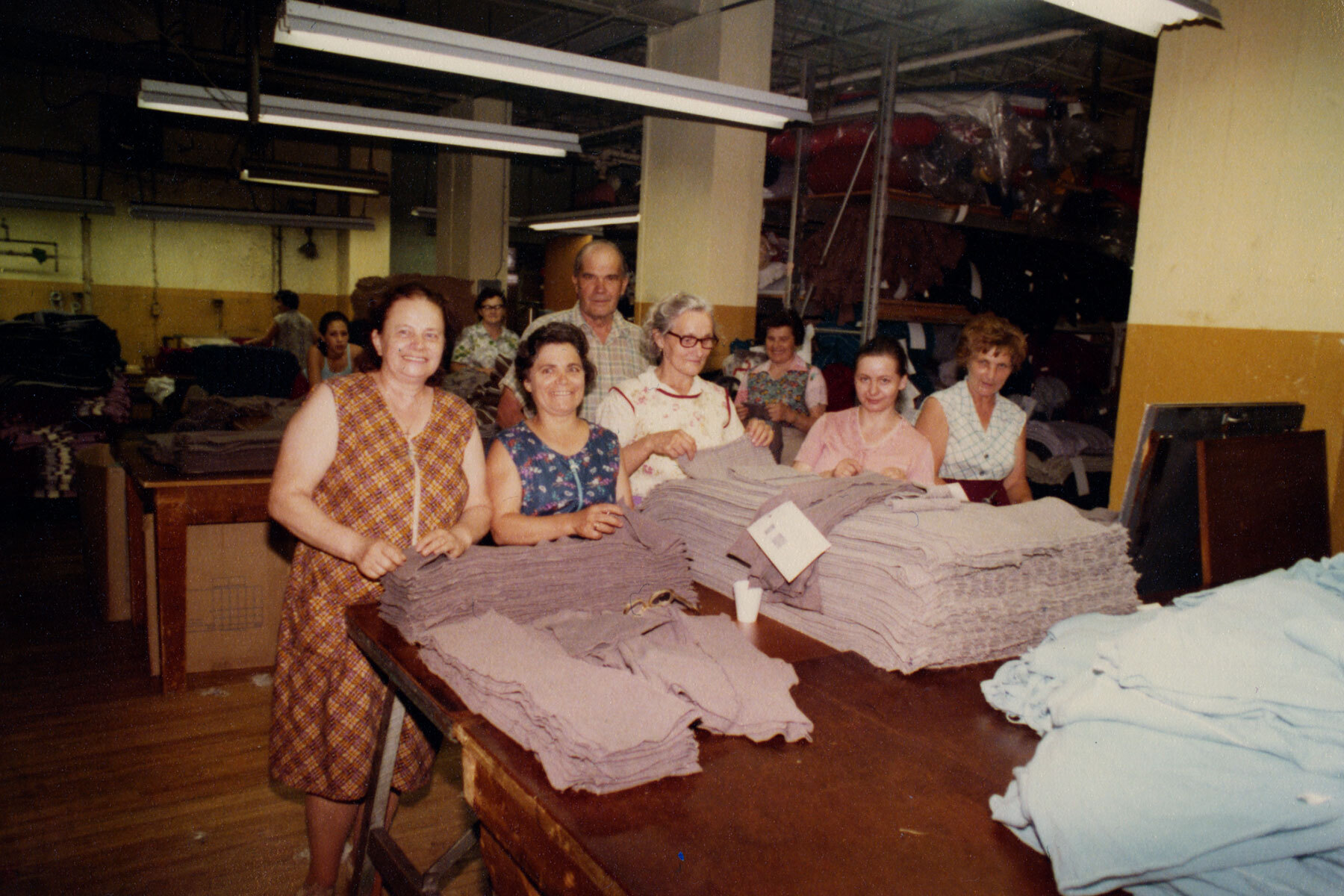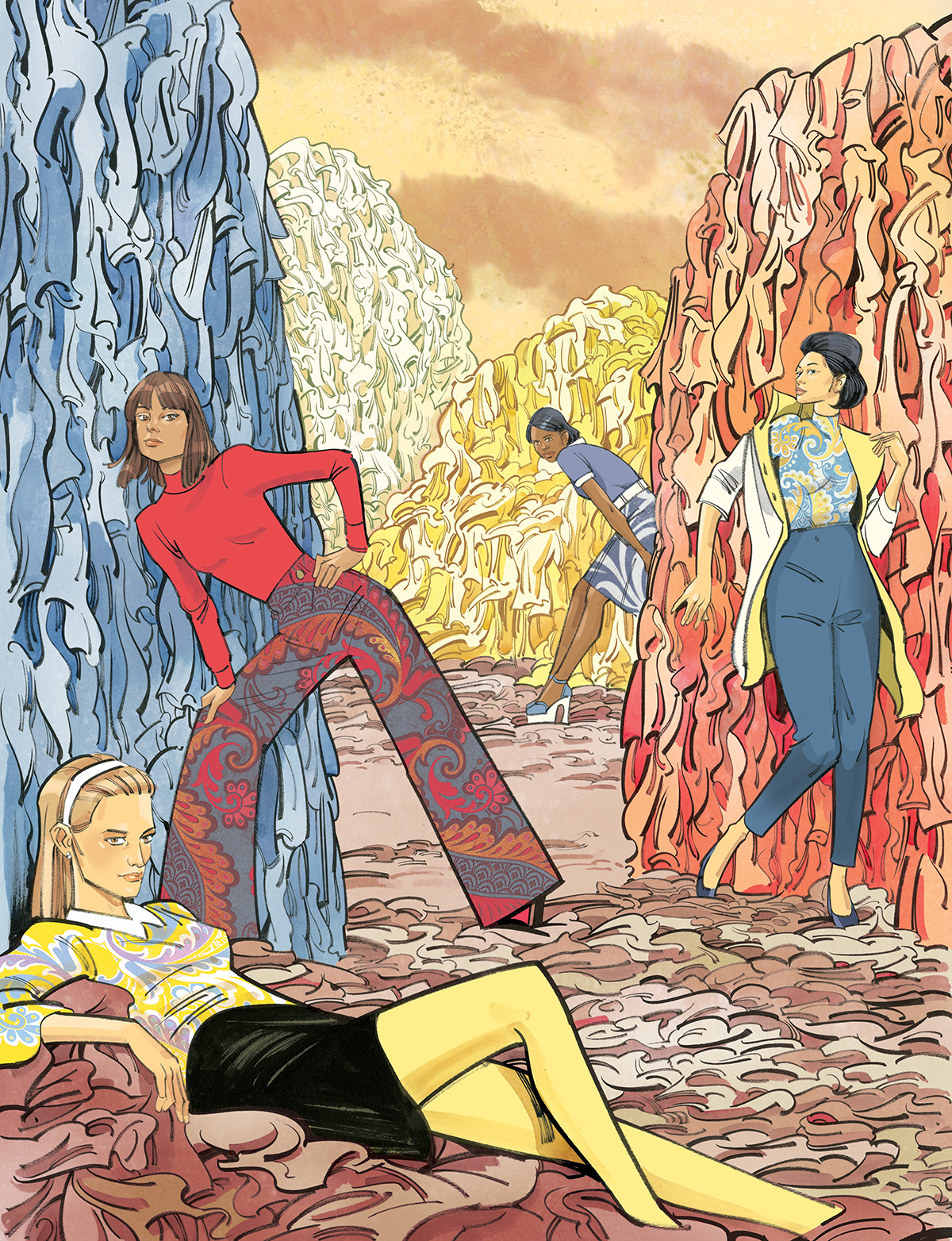The closest thing I have to a family heirloom is a black miniskirt. It’s perfect—above the knee but not too short. The pleating and A-line shape give it a modish look without being too era specific. My mother bought it for herself sometime in the 1970s. She passed it along to a younger cousin. My older sister had it next, before I appropriated it in my teens. The label reads “Gaytown Sportswear, Toronto.”
Though it hasn’t fit me for years, the skirt still hangs in my closet in honour of its years of service. It shares space with less worthy pieces: a green sweater that’s gone through one winter but is already starting to pill, a blue shirt that wrinkles if you so much as look at it.
As the $100 billion fast fashion industry has flooded the world with cheap, trendy items, shopping has become a crapshoot. Across social media, you’ll see frustrations over garments’ meagre lifespans. Studies have backed up my irritation with increasingly flimsy T-shirts: University of Kentucky textile researchers have found that they’ve become thinner over the years, as have fabrics. Denim, known for its hard-wearing history, hasn’t fared much better. Experts point to a decline in quality when comparing jeans made in the past five years or so to their counterparts from, say, the ’80s.
Mid-market shops, once a bastion of higher standards, have become hit or miss. Complaints are easy to find on Reddit: “Aritzia is starting to feel like that boyfriend that was once good to us and the letting go process has been difficult to accept.” J. Crew comes up often, with one user grumbling that a $125-plus cashmere sweater “just got a hole in it after one single year of use.” Buyers on YouTube lament the deteriorating craftsmanship in luxury brands too, hoisting up $1,000 bags that come up short. One study found that recently made designer jeans were less durable than a new pair from Walmart. It’s starting to feel like quality has become price and label agnostic.
It’s difficult to consume less when items fall apart so quickly. According to the World Economic Forum, the production of clothing has about doubled since 2000, but the average garment is worn just seven to ten times. A 2021 report says Canadians are dumping 500,000 tonnes of clothes each year. Even when we donate to charities for reuse, a lot of it ends up getting exported and becoming other countries’ problems. A mountain of cast-offs in the desert of Chile is literally visible from space. A clothing landfill in Ghana exploded, burning for days.
We’re in the golden age of garbage clothes. My mother’s made-in-Canada miniskirt feels like a relic from another world. Why do off-the-rack garments from the ’70s feel so much better than anything you can get today?

After my mother and grandmother moved here from Poland in the late 1960s, my grandmother quickly got a job at the National Knitting Mills factory in Toronto, where she worked for fourteen years. Toronto was a major garment-manufacturing hub back then, as was Montreal. Though Central Canada was the centre of the industry, textile mills or clothing manufacturers existed in most of the provinces, with Alberta and Manitoba known for their denim.
Around this time, many manufacturers were frustrated with what they felt was a lack of federal support for their industry. They warned of mass job losses as Canada struck a trade deal with China that opened up Canadian grain exports while allowing in some $7 million worth of textile imports, a move they said would cost the Canadian garment industry tens of millions of dollars in lost business. Tensions rose in the ’70s as members of Parliament from Western Canada wanted to further open up exports of wheat, fuel, and other products to Pacific Rim countries that had growing clothing industries.
What protected local manufacturing in this moment? An oddly Canadian set of circumstances, according to Rianne Mahon’s book The Politics of Industrial Restructuring: Canadian Textiles. In addition to unease about the possibility of labour unrest, Quebec’s massive garment workforce was of particular concern to the federal government: mass manufacturing layoffs might make separatism more appealing to voters.
In 1974, Canada ended up signing the Multifibre Arrangement, or the MFA, a global treaty which introduced quotas on imports from countries such as China and India. By 1979, imports made up less of the market than in 1975.
As a result, a sense of style seemed to be developing within the country. Canada’s Fashion History Museum points to the period from the ’70s to the ’90s as a golden era for Toronto fashion. The Canadian Fashion Annual published in 1988 highlighted dozens of designers, linking big names with local brands: Princess Diana with Pat McDonagh, Jane Fonda with Wayne Clark, David Bowie with Roots, Mick Jagger and Meryl Streep with Parachute, and Carol Burnett with Dean and Dan, the Caten brothers who now run DSquared2 out of Milan.
Advertisements and articles at the time frequently asserted that the goods were well made and designed to hold up. It’s not that crappy clothes didn’t exist (fashion historian Ivan Sayers told me, “There’s always been junk, and there’s always been fabulous”), but decent apparel was more accessible. My mother, never one to splash out on clothes, could buy a workaday skirt that lasted. I grew up with other pieces, too, from this era, including the shirts my grandmother wore when the factory she worked at went on strike (family lore has it she had a different outfit every day on the picket line).
But the quotas and protections for Canadian manufacturing were short lived. From the mid-’80s to the ’90s, governments around the world started to warm up to policies that removed trade barriers and import controls. The MFA also had its detractors—quotas were seen as discriminatory, differing from country to country. Some experts say the arrangement developed a black market for imports, and exporting countries got around limits by shipping to a third country less restricted by quotas and then re-exporting the products to the final import destination. In 1992, imported clothing made up 35 percent of the Canadian market. The North American Free Trade Agreement—NAFTA—of 1994 saw governments move away from protectionist measures. And so the MFA was terminated globally in 1995, and import quotas began their ten-year phase-out.
By 2004, imported goods supplied over 60 percent of Canada’s clothes. Once the MFA officially lapsed in 2005, imports kept ticking upward. In the early aughts, tens of thousands of clothing jobs in Canada disappeared. As of 2020, 95 percent of the apparel bought in Canada was imported, with most clothes now coming from China, Vietnam, and Bangladesh.
The end of the MFA ushered in a race to the bottom when it came to prices, with many companies turning toward Asian and Latin American countries with far fewer environmental and labour safeguards and a penchant for synthetic fabrics. For the first time in history, clothing became disposable.
It took years for us to get to our current mode of shop and toss. You can’t have fast fashion without synthetics, some of which were first engineered more than a century ago, when researchers invented dupes for more expensive or scarce textiles. Rayon or viscose is a semi synthetic made from chemically treated wood pulp that became popular during the Great Depression as a cheaper alternative to silk. Polyurethane, created in Nazi Germany, was a rubber replacement that was later used to create what’s now called elastane, spandex, or Lycra. Acrylic, often used as a substitute for wool, is a plastic-based product first mass produced in the US in the mid-1940s. Nylon, a petroleum-based fabric, was created in the 1930s and became popular for its affordability and durability alongside the wartime shortages of silk and cotton. Then there’s polyester, first developed between the 1930s and ’40s by the same inventors of nylon.
As the price of the petroleum-based polyester dropped in the 1960s, shoppers flocked to it. In the US, cotton was eclipsed by polyester within a decade. Polyester was low maintenance. It didn’t need much ironing. It dried quickly. It kept the pleating in skirts and creases in trousers and easily lent itself to bold colours that didn’t fade in the wash. It was lighter than wool. Today, polyester, nylon, acrylic, and other synthetic fibres account for around 65 percent of the material that makes up our clothes worldwide. They’re blended into cotton T-shirts and underwear, used as performance material in hiking and workout wear, and sometimes rebranded as the fancier-sounding “vegan silk.” Even fashion houses rely on synthetics. They’re in $6,000 Oscar de la Renta gowns and some of Chanel’s iconic jackets.
In other words, our clothes are made using huge amounts of petrochemicals and fossil fuels. When you wash the clothes, they keep polluting by shedding microplastics. Polyester comprises about 80 percent of all synthetic fibre use. Some consumers are frustrated by this synthetic creep, often holding up polyester as a sign of cost-cutting measures—it’s about half as much per kilogram as cotton and cheaper than wool. There’s also a contradiction at the heart of polyester. It’s both functionally indestructible—synthetic fabrics take forever to break down and decompose—and can sometimes pill easily, which tends to lead to garments having shorter lifespans.
“Not all polyester is created equal,” says Jennifer Wang, a pharmacist and fashion content creator. With a scientist’s rigour and an influencer’s charm, she breaks down what makes a good garment, and her videos have netted her nearly 400,000 followers on TikTok. In one video, she says her favourite dress pants are made from polyester. But the polyester fabric used in fast fashion is terrible and prone to wrinkling, defeating its versatile purpose. Different grades perform differently, making it tricky for consumers to live by hard-and-fast shopping rules like “no polyester.”
Wang refuses to generalize by fabric type, or even brand, given the variations in quality. She broke out online with a TikTok called “Stop Wasting Your Money at Aritzia” and similar videos assessing clothes from Lululemon, Reformation, Frank and Oak, and many more. She sometimes films from the shop floor, pointing out messy seams and scrunching fabric to show how quickly it wrinkles. Based in Toronto, she’s become a kind of guerilla quality-control officer, stepping into the role just as many companies have shirked the responsibility.
Meeting Wang in person, I hand over my mother’s miniskirt for her assessment. At 100 percent polyester, is it junk, the 1970s equivalent of fast fashion?
“For something that’s decades old, it looks fantastic,” Wang says. She points out that there’s no visible snagging on the fabric. All the seams are straight, and the pleats are stitched down and secured in place. The zipper still runs smoothly. All in all, she says, it’s quite well made, with some details now associated more with high-end brands.
Synthetics are inextricable from clothing getting crappier. But there’s so much more to good clothes than just fabric.
Ihave tried on high-waisted dress pants and wondered whether a human being was ever meant to sit down in them. My smallish to average head has struggled to break through turtlenecks that seem to have been made without an understanding of what the wee opening at the top was for. In fitting rooms, I have marvelled at the scientific impossibility of stretchy shirts that are both too tight and too big at the same time. In stores, I have come across plenty of dangling threads and buttons while shopping. Something has come loose in fashion—there’s been a shift in construction standards and quality control.
Judy Cornish and Joyce Gunhouse, who started their Toronto-based label Comrags in 1983, remember quality-control changes happening in the ’90s as free trade agreements ramped up. About thirty years ago, if you purchased wool from a mill, Cornish says, it would be table ready. “When you cut and sewed it, it stayed the same size and shape as the wool was intended to be,” she says. “But now they send you wool that hasn’t been steamed. So it hasn’t been finished.” This makes it harder to know how a fabric might behave once made into a piece of clothing unless, like Cornish and Gunhouse, you do the testing yourself beforehand. As more and more companies forgo fabric testing as a cost-cutting measure, quality problems, such as a shirt shrinking or a dress coming apart at the seams, often follow. Cornish believes this is also why so many contemporary clothes have “dry clean only” labels—it’s quicker and cheaper to recommend dry cleaning than to actually test out what happens to the garment when you wash it.
Gunhouse and Cornish keep a close eye on how their clothes are made—they’re constructed in the studio above their Dundas West boutique, and the majority of garments are washed by hand to see how they fare after cleaning. But it’s much less likely that a brand owned by a profit-obsessed private equity group or a large fashion brand moving as quickly as possible scrutinizes its products as closely, especially as production schedules have ramped up exponentially.
Comrags releases two collections of clothes per year: one in spring/summer, the other in fall/winter. This was the industry standard until rapid and frequent releases of clothing became widespread, putting pressure on labels to produce more (Chanel now releases six seasons a year). And then there’s fast fashion. Zara, H&M, and Forever 21 rose up in the early to mid 2010s, accelerating design timelines and drops. Zara, seen as a pioneer of the model, is able to go from design to sales floor in a matter of weeks. Some brands release up to fifty-two micro seasons a year. According to Sheng Lu, professor at the University of Delaware, in 2021, Zara offered 50,000 new SKUs—stock keeping units, or individual styles—on its website; H&M offered 25,000. With rapid, frequent releases at a dizzying scale, it’s hard to see how it’s possible to put out new clothes every week without design and construction taking a back seat.
The once-a-week timeline sounds almost quaint compared to the latest trend: ultra-fast fashion, with a glut of options daily.
The rise of e-commerce, turbocharged by the COVID-19 lockdowns, has given rise to direct-to-consumer brands such as Shein, Boohoo, and PrettyLittleThing, which largely operate without brick-and-mortar stores. These companies spit out collections at an unprecedented speed and of questionable quality.
Taylor Brydges is a research principal at the Institute for Sustainable Futures at the University of Technology Sydney in Australia, where she is studying ultra-fast fashion. When it comes to these brands, quality considerations like fit or fabric often go out the window. The clothes “are really designed to be worn about once. Or to be consumed digitally. I don’t think it has anything to do with how a garment looks and feels on a body, but how it’s photographed,” she says. Everyone is a celebrity on their own Instagram feeds: the pressure to always look good on social media, and to never repeat an outfit that might appear in your friends’ posts, has helped drive overconsumption, all of it aided by low prices.
Shein uses algorithms on its site to see what shoppers are buying and where, tailoring production to data patterns. While that sounds less wasteful than the explosion of goods under fast fashion, it’s not. The company releases up to 10,000 new items a day. And the prices are often so low they can defy belief, encouraging huge hauls and more consumption. A tube top for $2.44, women’s pants for $5.75, a pair of men’s shorts for $4. The quality is not only dubious but dangerous. A CBC report found that a Shein trench coat for a toddler contained nearly twenty times the amount of lead allowed in children’s products.
Like the mass-market clothing companies that have come before it, Shein has been accused of shocking environmental and labour abuses. According to an investigative documentary from the UK’s Channel 4, workers in China were paid as little as four cents per item while working eighteen-hour shifts.
For years, workers, activists, and researchers have sounded the alarm about horrible working conditions in an industry that’s producing more and more clothes. Textile workers are exposed to dust and carcinogens that can cause respiratory problems and cancer. Many have lost their lives while making clothes—the 2013 Rana Plaza collapse in Bangladesh killed more than 1,100 workers. Fabric dyes are poisoning waterways, and the microplastics shed when synthetic clothes are washed are found literally everywhere, from Antarctic snow to human blood.
None of this has slowed the rise of ultra-fast fashion. Shein is currently on track to hit nearly $60 billion (US) in 2025, essentially doubling its revenue from 2022. For every shopper alarmed by the implications of disposable clothes, plenty of others are happy to look the other way.
If I wanted to buy a new skirt to rival the one my mother passed down, what should I do?
Fashion media tells me to “invest” in something higher priced. Prada promises the “sleek allure” of a black miniskirt made from plastic garbage pulled from the ocean and recycled into a nylon garment. It’s $1,590. And if I gain weight? Investment gone. I type “black skirt” into the Hudson’s Bay site. It conjures up 127 results. For $99, I can buy a 78 percent nylon, 22 percent spandex skirt from Donna Karan. Or a Noisy May skirt, 95 percent cotton and 5 percent elastane, for $45. Meanwhile, at Reformation, there are ninety-nine options. A Maria Knit skirt is $188—88 percent TENCEL™ Lyocell, a fibre made from raw materials like eucalyptus trees, plus 12 percent spandex. COS has sixty-three options, including a low-rise deconstructed miniskirt with raw edges for $135 (US)—the site ships to Canada but won’t let me see the Canadian price until I go through nearly all the purchasing steps. It’s 54 percent polyester, 44 percent wool, 2 percent elastane, and “unwashable.”
Aritzia offers many choices, including a 100 percent polyester pleated midi skirt. It’s made with recycled materials, priced at $148, and well reviewed at just over four stars—it’s great, unless, one buyer warns, you’re short. Which I am. Zara has 114 options, while H&M has 141. A knee-length viscose number from the latter is $24.99. But it earned only 3.5 stars out of five, with some reviewers saying it’s see-through. Shein offers endless choices, many of them at less than $15. An Amazon search yields over 90,000 possibilities. So many black skirts, so many potential pieces of landfill: it feels hard to choose right.
A generation ago, my mother could walk into a store and buy something made in a local factory with labour and environmental guardrails and not have to weigh a mind-numbing amount of options. Today, a simple purchase can feel like running the gauntlet of anxieties about fit, longevity, and style, with ethical and environmental concerns added for good measure.
In the past few years, I’ve tried to shop second hand. It’s not a perfect system, but I’ve managed to find older pieces that have some of the quality hallmarks that feel so lacking today. The newer makes, at a fraction of their retail price, are also less of a financial hit even if they don’t last as long as I hope.
But it often feels like an exercise in futility, given the tidal wave of new clothes coming out all the time, with some experts pointing out that oversupply is leading to untold numbers of new, unsold clothes being thrown out. So what if I’m not buying? Huge piles of clothes will still end up being incinerated or mouldering in a dump.
“The fashion industry has done such a good job of putting the responsibility on consumers to be responsible for their ways,” Brydges says. She’s skeptical that companies will change their practices of their own volition. Though some small changes are starting to crop up. The McKinsey Global Institute, in its 2024 report on the state of fashion, has said that the era of fashion self-regulation is coming to an end.
In South Africa, Brazil, the US, and EU, lawmakers are pushing for changes to plug the tax and customs loopholes used by ultra-fast fashion companies: the price tags are so low, in part, because largely direct-to-consumer brands like Shein are able to avoid customs fees when a buyer gets a sweater shipped to their home. The EU has come out with new regulations making brands responsible for end-of-life waste treatment, by banning the destruction of unsold or returned textiles and creating new systems to separate clothing waste from other garbage. In an effort to combat microplastics, the EU is also looking into legislation mandating plastic filters for washing machines as well as the product design of garments. Australia is introducing a four-cent levy on the sales of clothes to help fund clothing-recycling facilities. Canada has slowly moved in this direction with an act to establish a textile waste strategy and a promise to look into the microplastics problem. Brydges, who wrote her PhD thesis on made-in-Canada clothes, points out that fashion is a bit of an orphaned industry here. Lawmakers haven’t really known what to do about it.
Perhaps the clothing industry has been able to hide dirty secrets behind its reputation for frivolity. But fashion is a trillion-dollar business with enormous global implications. For Brydges, consumers need to shift how they think about what they buy. “Whether or not you like it, you’re a part of the fashion industry by virtue of getting dressed,” she says. Behaviour, and expectations about what we wear, need to shift.
But there’s a limit to how much I can do as one consumer—scrutinizing stitching and fabric labels and trying to act as my own quality-control officer amid an ocean of options. Shouldn’t governments treat the problem more seriously? Shouldn’t we at least try to dig ourselves out of this massive clothing mess? I don’t expect every black skirt in the world to reach heirloom status. Still, it should be a simple ask: I want to be able to buy something that lasts.
Correction, October 23, 2024: An earlier version of this article implied that Taylor Brydges is the sole research principal at the Institute for Sustainable Futures. Additionally, it stated that the institute will be studying ultra-fast fashion. In fact, Brydges is part of a team; she is studying ultra-fast fashion. The Walrus regrets the error.





